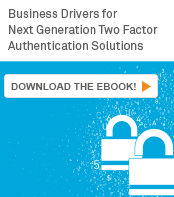This post originally appeared on SafeNet’s The Art of Data Protection blog prior to Gemalto’s acquisition of SafeNet.
 This is the first time, after many years in the Identity Management and Authentication business, that I can truly say, that a broad industry effort is in motion to bring the era of password authentication to an end. The adoption of cloud, along with changing user expectations around authentication, is creating a fundamental shift in awareness in how we – as end users and organizations – authenticate to networks, applications and services.
This is the first time, after many years in the Identity Management and Authentication business, that I can truly say, that a broad industry effort is in motion to bring the era of password authentication to an end. The adoption of cloud, along with changing user expectations around authentication, is creating a fundamental shift in awareness in how we – as end users and organizations – authenticate to networks, applications and services.
2014 bodes exciting developments for the authentication market. I believe this will be a year in which we will witness the embrace of new authentication schemes that will further change the way we protect our accounts and identities in the cloud. On one end, having a seamless, portable identity and authentication tools that do not require us to remember dozens of passwords, will become possible. At the same time, more and more services will become more secure by abandoning the reliance on passwords and moving to strong authentication, identity federation and single-sign-on technologies.
Below are some of the trends I see bringing us closer to this reality:
- Enterprises will be more proactive in securing their networks and cloud services. The need for enterprises to tighten access controls for their private and public cloud services will drive adoption of delivery models that offer cloud-based authentication and single sign on solutions for enterprise cloud services, public clouds and corporate networks.
- Enhanced security from cloud and SaaS providers. Cloud adoption is galloping forward, as threat vectors continue to escalate. As a result, enterprises will be more strident in their demands that cloud providers secure their offerings with HSM-based hardware-root-of-trust. Amazon has already taken a first step in this direction by offering Amazon Cloud HSM which secures their services and encryption keys.
- Customer demands for ease of use and frictionless authentication will drive improvements. Customers’ expectations for seamless trusted authentication and the continued dominance of smart phones and smart devices will accelerate the move from legacy hardware One-Time-Password tokens to mobile friendly, embedded security and contextual access controls. These methods will rely on security elements built into devices, and leverage device sensors to authenticate users. We can already see early examples in Apple’s iTouch for biometric authentication, and investments by vendors such as Samsung to bake enterprise grade security controls into their KNOX platform.
- The need for an interoperable and universal authentication framework. As the lines between different types of identities blur, there will be a greater demand for an authentication framework that can offer better assurance than passwords and which can be implemented across different environments and use cases. Developments in this direction are being taken by the FIDO Alliance whose aim is to develop a universally flexible authentication framework for consumers.
The trends I’ve mentioned above reflect a convergence of interest between end users and businesses. We have reached the point where we recognize the fact that static passwords need to go. It is exciting to know that the alternative authentication approaches currently evolving will be easier to deploy, easier to use, and make it easier for us to do business securely.
 If you want to learn how organizations must respond to next-generation authentication trends, download our free ebook, Business Drivers for Next-Generation Two-Factor Authentication Solutions.
If you want to learn how organizations must respond to next-generation authentication trends, download our free ebook, Business Drivers for Next-Generation Two-Factor Authentication Solutions.
In this ebook, the challenges of a complex authentication environment are brought forth as encountered per enterprise stakeholder – including executives and HR, CFOs, CIOs, CSOs, and users – together with how these challenges can be redressed. Download the ebook now.


